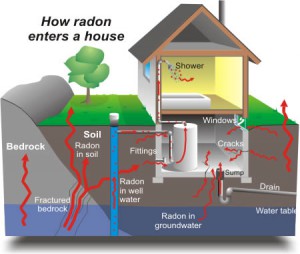Conduct Radon Gas Testing
You can’t see, smell it or taste radon gas…but it may be a problem in your home…and it can be dangerous. Radon is a cancer-causing, radioactive gas.
Radon comes from the natural (radioactive) breakdown of uranium in soil, rock and water and gets into the air we breathe. Radon can be found all over the U.S. It can get into any type of building – homes, offices, schools – and result in high indoor radon levels.
Any Home May Have A Radon Problem
This means new and old homes, well-sealed and drafty homes, and homes with or without basements.
 Radon gets in through:
Radon gets in through:
- Cracks in solid floors
- Construction joints
- Cracks in walls
- Gaps in suspended floors
- Gaps around service pipes
- Cavities inside walls
- The water supply
Why you should test for radon
Testing is the only way to know if you and your family are at risk from radon. EPA and the Surgeon General recommend testing all homes below the third floor for radon.
A radon house inspection is inexpensive and easy it should only take a few minutes of your time. Millions of Americans have already tested their homes for radon.
You can fix a radon problem
Radon reduction systems work and they are not too costly. Some radon reduction systems can reduce radon levels in your home by up to 99%. Even very high levels can be reduced to acceptable levels.
What to Do if High Radon Levels are Found
If elevated levels are found during your radon home inspection, the EPA recommends that it be mitigated. The buyer should request that the seller mitigate to below the necessary threshold. The cost of making repairs to reduce radon levels depends on how the home was built among other factors.For more facts about the dangers of radon and what it means to your family’s health, visit www.epa.gov/radon/healthrisks.html
New homes can be built with radon-resistant features
Radon-resistant construction techniques can be effective in preventing radon entry. When installed properly and completely, these simple and inexpensive techniques can help reduce indoor radon levels in homes.?In addition, installing them at the time of construction makes it easier and less expensive to reduce radon levels further if these passive techniques don’t reduce radon levels to below 4 pCi/L. Every new home should be tested after occupancy, even if it was built radon-resistant. If radon levels are still in excess of 4 pCi/L, the passive system should be activated by having a qualified mitigator install a vent fan. For more explanation of radon resistant construction techniques, refer to EPA publication,?Building Radon Out: A Step-by-Step Guide on How to Build Radon-Resistant Homes (see www.epa.gov/radon/rrnc).
Why Choose HomeMD?
As leaders in full-service home inspections, HomeMD is your best choice when you need radon testing in Louisville, KY. Unlike many of our competitors, we tell it to you straight, never scaring you with hypotheticals about what might happen. We are family owned and operated, meaning we understand how important it is to feel safe and secure in your home. The extensive experience and expertise we bring to your home make us a top radon inspection company serving the area today. To learn more about our radon testing services or to schedule your first appointment, reach out and talk to us today.


